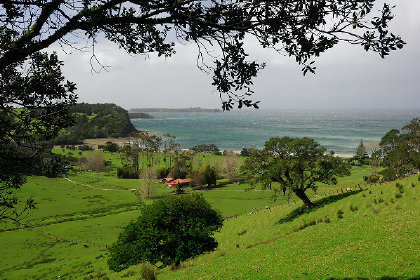Captain Jones’ legacy complete at Te Muri
Captain Jones had first tried to secure Ōrewa Beach.

Sum of the Parks: Mahurangi, Te Muri, Wenderholm and Motuora (in distance) form a maritime park much greater than the sum of the parts. photograph Auckland Regional Council
But £10 000 was too rich for the government of the day, and so most of the land between the highway sea was subdivided—with a single beach house now fetching the several million dollars that that figure equates to today.
That was around 1954, the year the Auckland Regional Planning Authority was created, with Captain Frederick William Osborn Jones the regional planning officer. But in 1960 ‘F W O’ gained an ally, Judge Arnold R Turner, and by 1965 the region had its first regional park: Wenderholm. Other park purchases quickly followed: Long Bay, Shakespear, and Mahurangi West. In 1973 the prime coastal land at Te Muri was purchased, with view linking Mahurangi and Wenderholm with a scenic road.
A remnant of the scenic road plan persevered, in the form of concrete plans for a road from the end of Ngārewa Drive, a bridge across Te Muri Estuary and parking for 4000 cars handy to the Ngārewa beach. Meantime, however, the locals had discovered the particular charms of a beach without vehicle access, and proposed walking access only. Judge Arnold Turner (since Judge Arnold Turner CMG) chaired the citizens advisory group that considered the walking access only proposal—the concept was enthusiastically embraced. Parks management was miffed, however, and subsequently rebuffed the citizens’ efforts to see a boardwalk built through the mangroves, to allow all-tide walking access. With the purchase now of the balance of the 64-hectare property—$15 million for 407 hectares—the instinct of parks management will be to justify the purchase by developing it for car access. The Auckland Regional Council’s media release mentions the beachfront as:
Crossing Te Muri estuary is a large part of the charm of reaching the beach. The place, aside from a recent obtrusive dwelling, has a deserted feeling that provides a surprisingly rare respite, so close to the metropolis. Most of the region’s parks suffer from a shortcoming that dates to pre-oil-shock thinking that was all about providing opportunities for ordinary families, each in their own car. Te Muri provides a perfect opportunity to design access around public transport. Part of the vision that so captured the imagination of the citizens advisory group in 1988, was for a coastal walkway:
The potential exists for the authority to develop an exiting new coastal walkway linking Waiwera to Mahurangi, the Waiwera section already complete.
Waiwera has long had a comprehensive bus service, thanks to the regional council’s predecessor, the Auckland Regional Authority. From the Waiwera River to Ōpahi via the shoreline is some 10 kilometres—a significant coastal walkway, all within regional park. While boardwalking the upper Te Muri estuary is a trivial matter, bridging Pūhoi River is not. But here, history helps—the Pūhoi once boasted a pivot bridge, as part of the Main North Road. Swinging a pivot bridge open to allow the occasional yacht to venture upriver could conceivably be the highlight of a holiday.
From pre-European times through the steamer era, visitors experienced the Mahurangi initially via the water—the sea connecting all. In the brief heyday of the car, the coast is broken into sections centred on car parks. Te Muri is an opportunity to restore the integrity and supremacy of the coastline and trail—to make walkers and canoeists the first class citizens. By developing Te Muri for non-vehicle access, regional parks policymakers should send a powerful signal: The future is shared transport. But never mind the issue of car-centric parks, some have never been fond of regional parks, full stop. Judge Arnold Turner says:
Rodney County Council was not entirely happy with our purchase of Wenderholm, because there was already a scheme plan of subdivision in existence…
…as there was at Te Muri, prior to its purchase. The anti– regional governance mayor of the soon to be late and unlamented Rodney council said she was:
appalled by the Auckland Regional Council’s announcement today of its $15 million purchase of land…
Curious how the likes of this ex-Act dogmatist say they love the regional parks but are never in support of actually buying ’em.
The Mahurangi Magazine salutes the councillors, particularly Christine ‘Vote Rose for Rodney’ Rose, for their courage in securing Te Muri in the final weeks of the regional council’s existence—a fitting finale for Aotearoa’s first regional authority, and proud beginning for the new region-wide council.
And rich realisation of the shining vision of F W O Jones.
